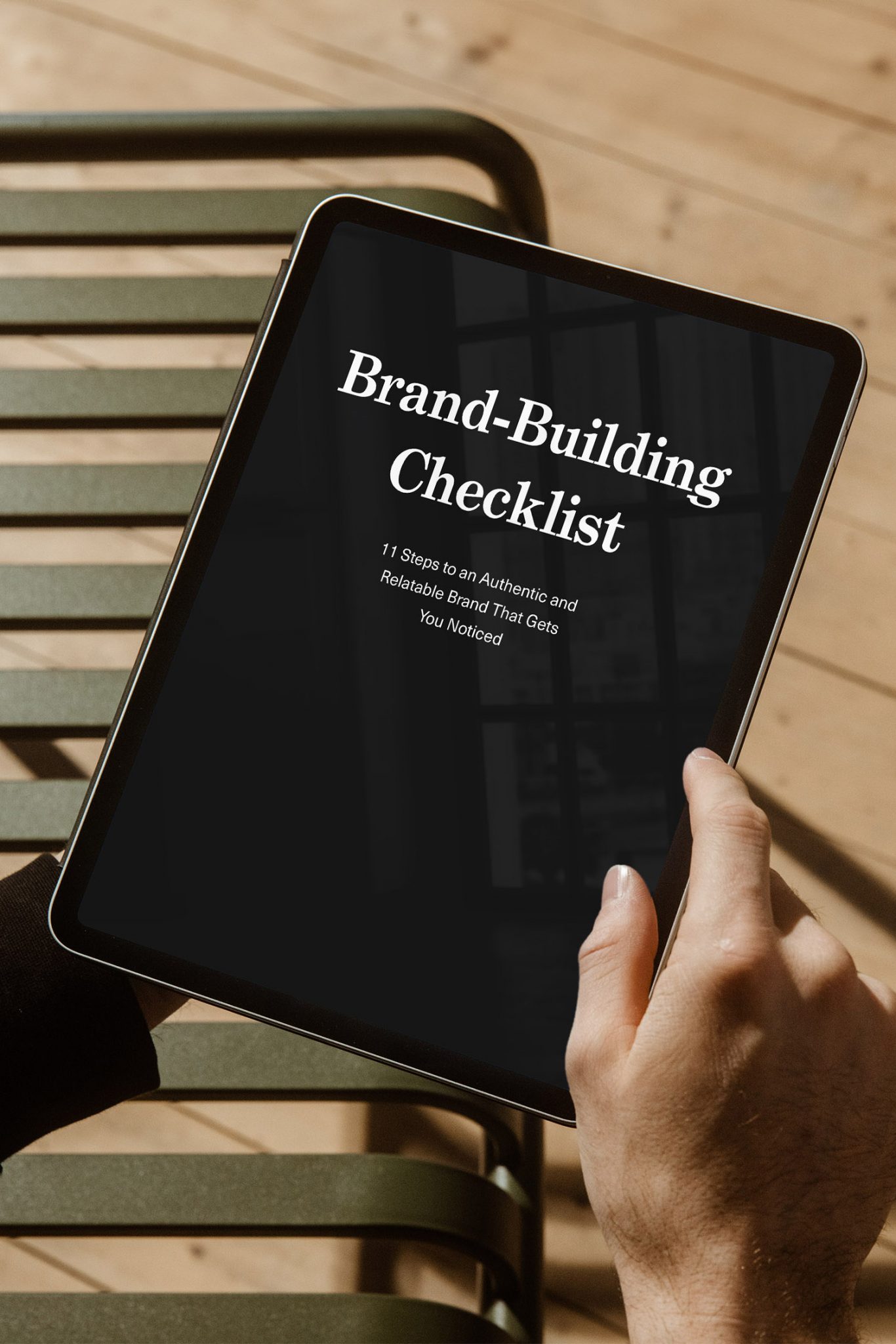But what is a brand voice? And how to create one? In this article, I’ll give you a comprehensive rundown of the topic.
I’ve compiled six easy steps to help you develop your brand voice. Additionally, we’ll look at some excellent brand voice examples.
By the end, you’ll be able to develop a brand voice that reflects your company’s unique personality, sets it apart from the competition, resonates with your audience and retains their loyalty to your brand.
So, let’s get started.
What Is a Brand Voice?
A company’s brand voice refers to the tone of voice, choice of words and style of language associated with that brand and used in all verbal communication.
It not only reflects the brand’s positioning, identity, and message but also helps build a human connection between the company and its target audience and differentiates it from the competition.
A consistent brand voice across all touchpoints is one of the most important factors in building trust with the audience.
Similar to how people adapt their tone of voice to the environment, a brand voice can also be adaptable.
For example, the tone in advertising copy could be slightly more daring and provocative than in customer interactions. Similarly, a brand might use a casual tone of voice on TikTok while adopting a more serious tone on LinkedIn.
Key Elements of a Brand Voice
The brand voice consists of several elements. Together, they shape the brand’s unique sound and instil its character.
Brand Personality
Brand personality describes the unique characteristics and attributes that define a brand’s identity. It’s about infusing the brand with human-like traits that appeal to its target audience, such as authority, friendliness, playfulness or sophistication.
Brand personality is expressed not just in the brand voice but also in all forms of communication, be it visual or otherwise.
Here are a few examples:
- Red Bull’s personality is adventurous, encouraging and exciting to appeal to adrenaline junkies.
- Airbnb’s character is welcoming and inclusive, appealing to travellers seeking authentic experiences.
- Harley Davidson’s character is tough and rebellious to appeal to people who crave independence and adventure.
- Dove’s personality is uplifting and sincere, appealing to people who need confidence.
Tone of Voice
The tone of voice defines the general mood in which the personality is expressed. Depending on the brand and target group, it can be formal, neutral or informal.
The tone of voice can also vary within a brand, depending on the context.
For example, a brand may adopt a formal tone in official communications while choosing a more conversational tone when interacting with customers.
Language and Word Choice
By language, I mean the specific words and phrases chosen to convey the brand message.
Whether it’s industry-specific terms, informal language or vocabulary tailored to specific groups, it’s about using language that resonates with the audience and using it consistently.
Grammar, Syntax and Punctuation
Lastly, the brand voice also covers punctuation, syntax and grammar.
This includes decisions such as the use of en- (–) vs em-dashes (—), whether there should be contractions such as ‘it’s’, or the correct use of commas, full stops and other punctuation marks.
Consistency in all these areas ensures a uniform and professional appearance and makes all texts sound like they come from the same source.
Create a Distinctive Brand Voice in 6 Steps
1. Identify the Target audience
Start by studying your ideal and existing customers. Pinpointing your target audience allows you to tailor your brand voice to their expectations, interests, and language. This step is essential to engage with them at a personal level.
But how? Conduct market research and gather information about their demographics, psychographics, behaviours, needs, goals, and problems. You can run surveys, convene focus groups, and analyse existing customer data.
Do you notice patterns in the behaviours and characteristics of your existing customers? Which other brands do they engage with, and what do those brands sound like?
Ultimately, the secret is to sound uniquely you. People are looking for different voices and experiences from each brand they support.
To summarise your research, you may find it helpful to create personas. Personas are profiles of your ideal customers that you can later consult as stakeholders in your decision-making.
2. Study the Competition
Analyse your competitors’ tone. Look at their websites, scroll through their social media, and sign up for their newsletters.
What tone of voice do they use? Do you notice patterns in the way they communicate? Can you spot keywords or other frequently used phrases?
Studying your competitors’ brand voice can help you identify gaps in the market that your brand can fill.
For example, I like how Alto stands out among ordinary pharmacies. It sounds warmer, more human, and less sterile and salesy.
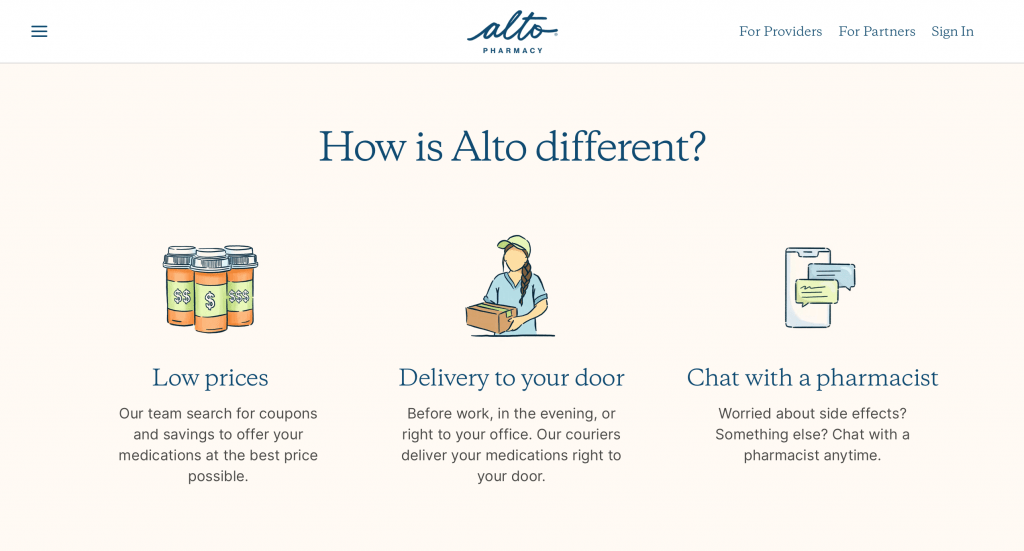
You can also draw inspiration from brands you are not competing with.
Imagine a brand voice that combines the styles of Lululemon and Apple. Or an insurance company with the brand voice of Harley Davidson.
3. Define Your Brand Identity
Combining the findings from competitor and audience research with your brand’s unique strengths and personality can help define a distinct identity for your brand.
It can help you imagine your brand as a person.
A person’s unique identity shines through in how they dress, behave, and speak—the topics they talk about and their tone. Similarly, a brand’s identity is expressed through its visual and verbal identity, as well as experiences and behaviours.
So, you could ask:
- What would my brand wear?
- Who would they hang out with?
- What would they eat?
- What social platforms would they use?
- What music do they listen to?
Answering these questions can help create a more detailed and nuanced picture of your brand.
One of the most important things you can do to build trust and credibility is to ensure that your brand identity aligns with your company’s values and beliefs. It should also be distinct from the competition and align with its audience.
This will drive the brand’s positioning, personality, and messaging, which ultimately translates into your brand voice.
4. Define Your Brand Voice
Now, it’s time to connect the dots. Think about what qualities you want your brand to be known for. Should its voice be formal or casual? Funny or serious?
Compiling a good mix of characteristics will keep your brand’s tone fresh and interesting. A good rule of thumb is to choose no more than five relevant traits.
Here are some examples of brand voice attributes to help you get started:
Adventurous
Authentic
Calm
Charismatic
Compassionate
Confident
Courageous
Creative
Curious
Dependable
Down-to-earth
Dynamic
Edgy
Energetic
Empathetic
Enthusiastic
Expressive
Fearless
Forward-thinking
Fresh
Friendly
Humble
Humorous
Honest
Imaginative
Innovative
Inspiring
Intuitive
Lighthearted
Modest
Nurturing
Optimistic
Playful
Practical
Professional
Progressive
Quirky
Relatable
Reliable
Resilient
Resourceful
Serious
Sophisticated
Spirited
Thoughtful
Thrilling
Trustworthy
Upbeat
Vibrant
Witty
5. Write Up Your Brand Voice Guidelines
Words are gold when building a deep connection with your target audience and maintaining your brand identity.
And just like with your visual brand elements, consistency is the key here.
So, how can you ensure that your brand voice remains consistent across all platforms and communication channels, even when multiple copywriters are involved?
The easiest way is to create a set of brand voice guidelines and stick to them religiously.
These guidelines could cover the elements we discussed earlier, such as:
- Personality: Describe your brand’s personality to humanise your brand and foster deeper connections with your audience.
- Tone of Voice: Explain the desired tone for your brand’s communication—whether you’re aiming for a knowledgeable, warm, or conversational tone.
- Adaptation: Explain if and how your brand voice can adapt to different platforms and channels.
- Grammar and Syntax: Establish clear grammar and sentence structure guidelines. Use simple sentence structure. Avoid unnecessary abbreviations and jargon, and use terminology consistently.
- Typography: Include rules around formatting phone numbers, what dashes to use, etc.
- Examples: Provide plenty of dos and don’ts examples to illustrate the application of your brand voice in different contexts. These examples will make your guidelines actionable.
Need inspiration for writing your brand voice guidelines? Here are some companies that have made theirs available.
Take a look at what they have done:
- Mailchimp brand voice guidelines
- Uber brand voice guidelines
- IBM brand voice guidelines
- Microsoft brand voice guidelines
- Ben tone of voice
You can find plenty more at Branding Syleguides. You just need to sign up to access plenty of brand guidelines—it’s free.
Brand Voice Chart
A brand voice chart is another good way to write down your tone of voice. Here’s an example:
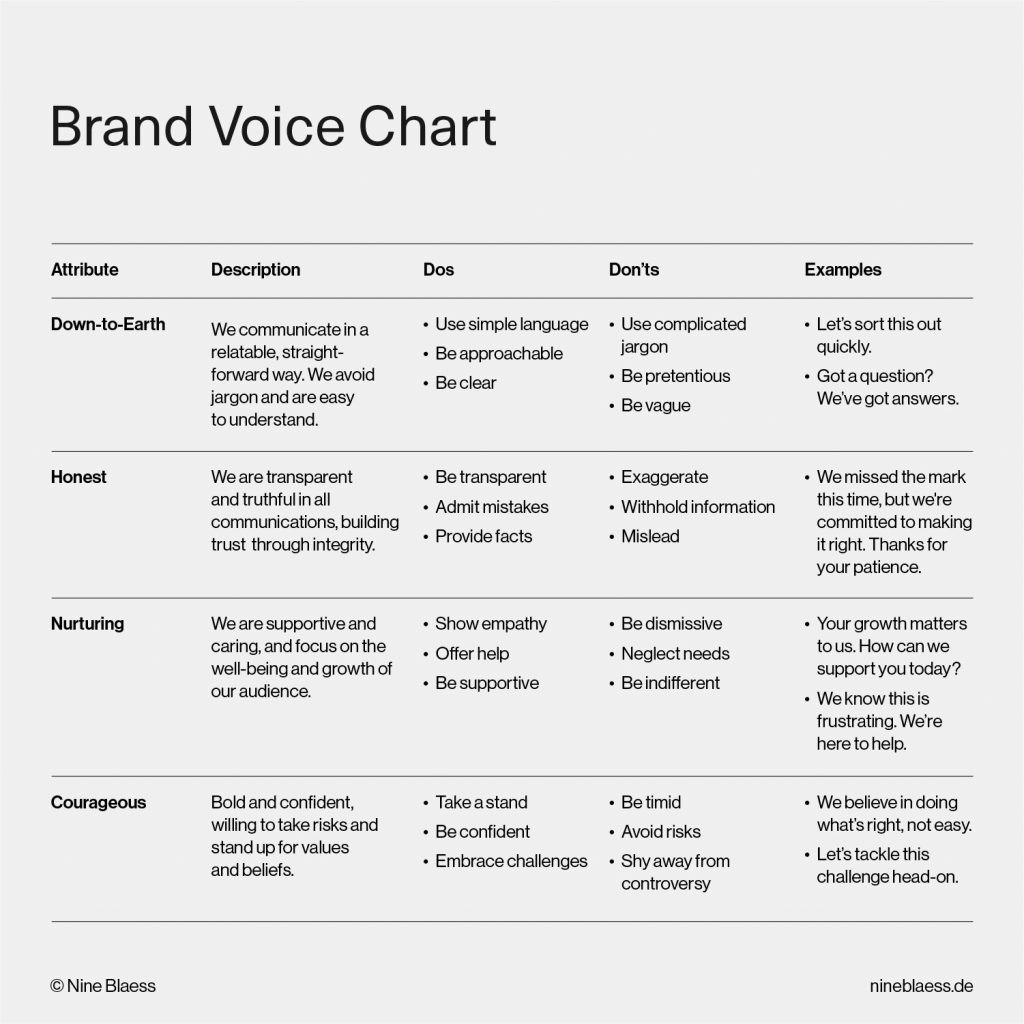
6. Maintain and Evolve the Brand Voice
Review your brand voice guidelines regularly to ensure they remain consistent and relevant to your evolving brand identity and target audience.
You can use customer feedback to refine and adjust your brand voice. Customer input can provide valuable insights into how your brand is perceived and help you make necessary adjustments to better resonate with your audience.
I know this is a lot to think about. But all of this work will pay off in time. With an authentic and memorable brand voice, people will listen to and trust your brand.
Brand Voice Examples
Now, let’s look at some examples of how others use their brand voice across different channels.
Oatly
Oatly is a plant-based food and beverage company known for its bold, unapologetic, and quirky brand voice. See for yourself.Oatly Ad: Difficult Age
Oatly on Twitter [1]

Oatly on Instagram [2]
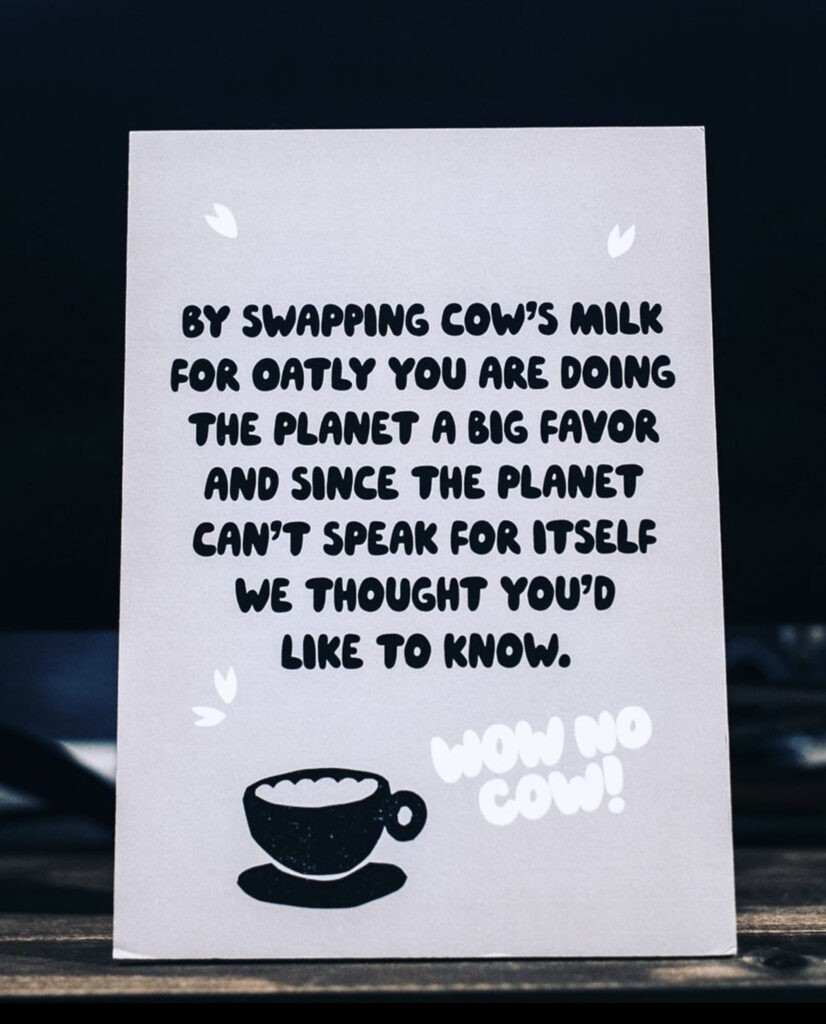
Dropbox
The Dropbox brand voice reflects the company’s focus on simplicity and ease of use by being straightforward, approachable, and confident.Dropbox Website [3]
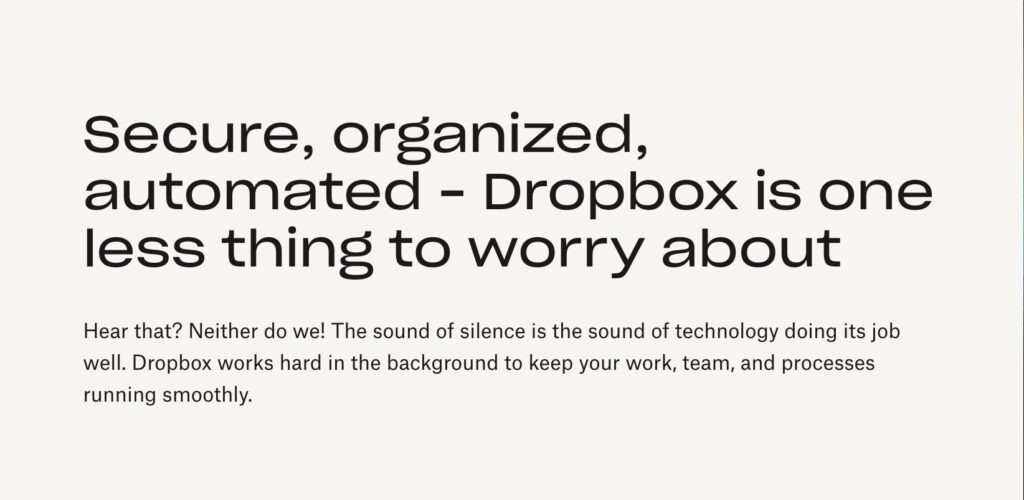
Dropbox on Twitter [4]

Allbirds
The brand voice of the sustainable footwear brand Allbirds is environmentally conscious, playful, and approachable. Allbirds never fails to bring in elements of surprise.
Allbirds Ad: Meet Your Shoes
Allbirds on Instagram [5]
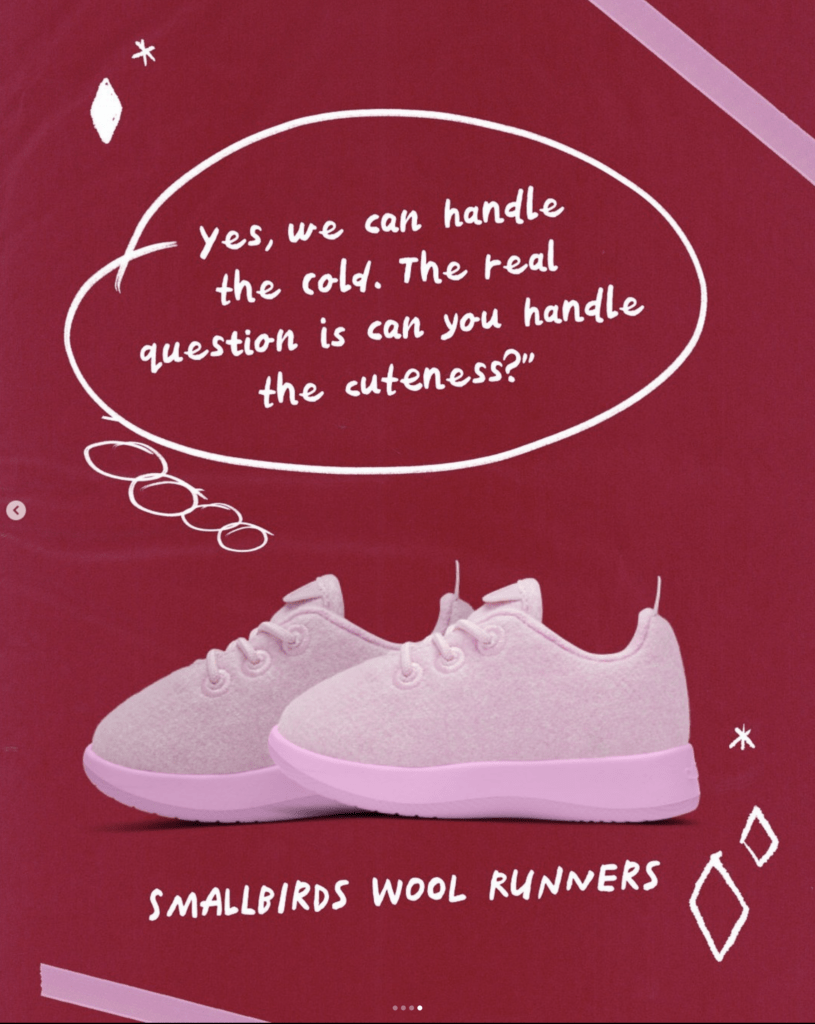
From the Allbirds sustainability report [6]
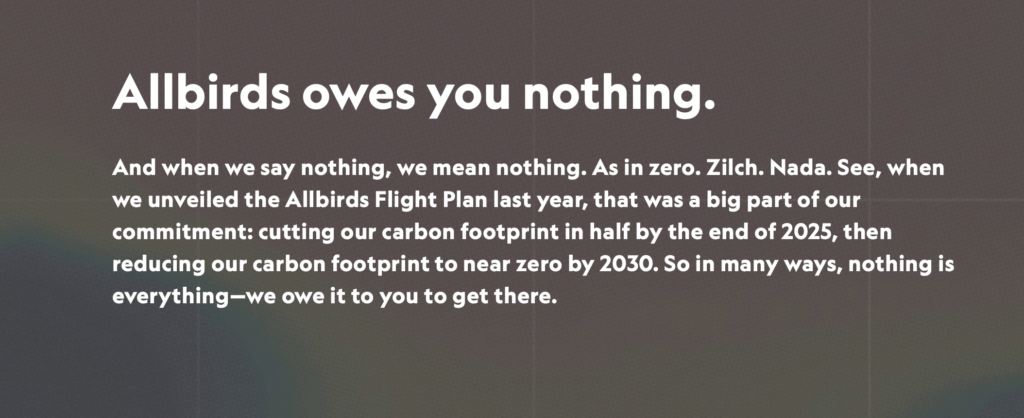
As these examples show, establishing and maintaining your brand voice is a big step towards building trust and recognition with your target audience.
Benefits of Having a Distinctive Brand Voice
To wrap up, let’s talk about why you should put this much effort into creating your brand voice. What’s to gain?
Some of the benefits are:
- Differentiation: A unique and consistent brand voice helps your brand stand out from competitors by giving it a distinct personality and tone.
- Trust: Customers are more likely to trust a brand that communicates in a reliable and consistent tone, reassuring them that the brand stands for something they care about. A well-defined brand voice creates an emotional connection with customers, allowing brands to communicate in a way that aligns with their audience’s values and feelings.
- Better Brand Recall: A distinctive voice makes the brand more likely to be remembered and instantly recognised.
- Consistency: A strong brand voice ensures consistency across all communication channels, from social media to customer service interactions, maintaining a cohesive brand image.
- Guiding Internal Culture: Internally, a clear brand voice helps align employees with the brand’s values and mission, guiding how they should communicate on behalf of the brand and ensuring that all public interactions reflect the brand’s identity.
Conclusion
Your brand voice is more than just a set of words; it’s an expression of your brand’s unique personality and identity.
By consistently delivering messages that reflect your brand values and promises, you can build trust, foster deeper relationships, and inspire greater loyalty in your audience.
This not only helps you attract new customers but also cultivates lifetime value with your existing ones.
To create a distinctive brand voice, start by understanding your audience and competition. Then, define your brand’s identity and set the tone for it. Finally, create brand voice guidelines to ensure consistency across all your communication channels.
It’s important to remember that building a great brand takes time and effort. Brands are not built overnight but through thousands of small gestures.
So, remain consistent and committed to your brand voice, even if the results are not immediately visible.
Whether you are starting a brand or looking to revamp your existing one, these tips will help you.
Your verbal identity is just one part of your branding and should be developed alongside your visual identity.
In this context, you might also enjoy these articles:
References
[1] Oatly on Twitter
[2] Oatly on Instagram
[3] Dropbox Website.
[4] Dropbox on Twitter.
[5] Allbirds on Instagram.
[6] Allbirds Website.
Title image by MART PRODUCTION






